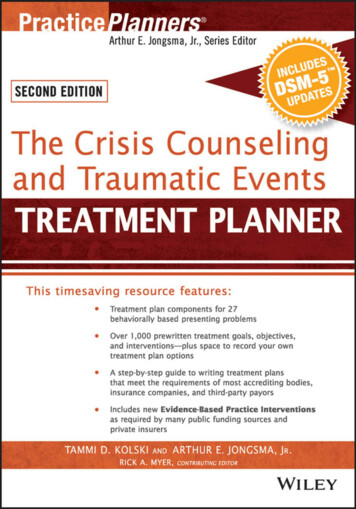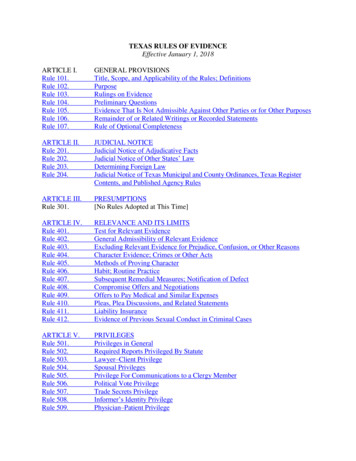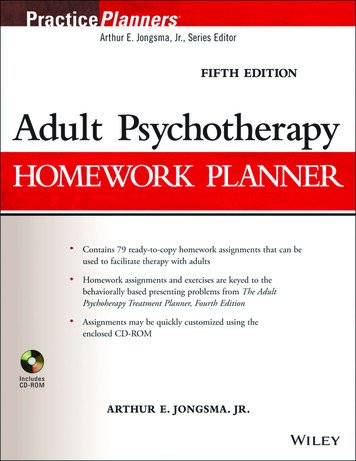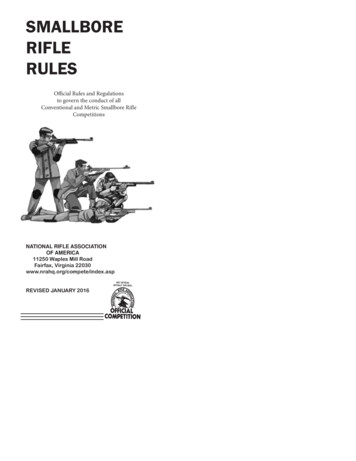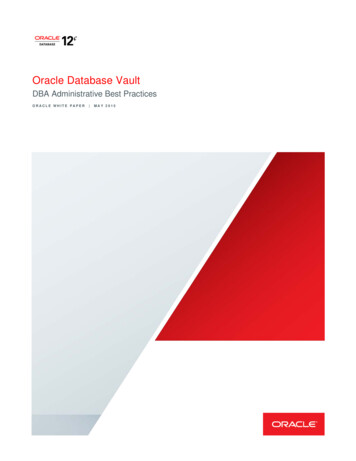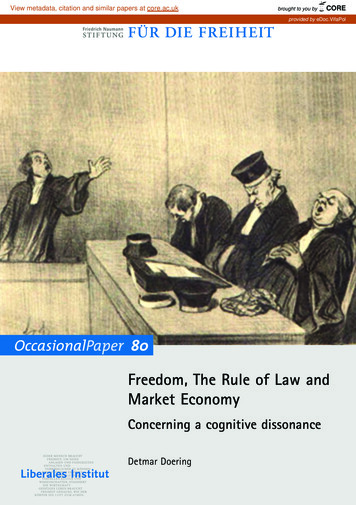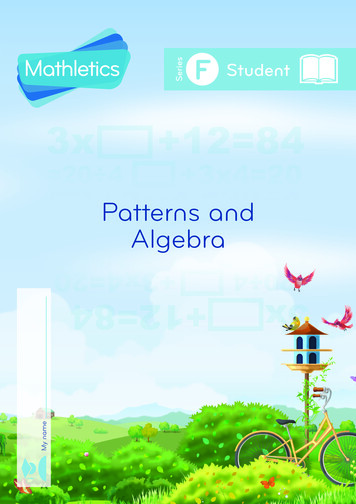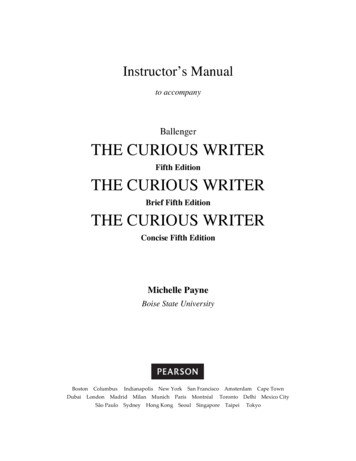
Transcription
Sixth Edition Rule BookEffective 1/1/2022Amended 4/11/2022
FASTPITCH AMERICA World Series and Nationals Qualification Guidelines:1. Teams must be FASTPITCH AMERICA Sanctioned.2. Attend the FASTPITCH AMERICA State Tournament in your home state or a RegionalQualifier Tournament for your area.3. Receive an at-large berth.4. Roster: Up to three pick-up players may be added to a team’s roster after the FASTPITCHAMERICA State Tournament / National Qualifier / NIT.Table of Contents1. Definitions2. Basics of Playing the Game3. Pitching Rules4. Batting and Base Running5. Official Lineup of Players and Substitutes6. Equipment7. Regulations of the “Playing Field”8. Umpire’s Rights and Responsibilities9. Tournament and League Play Guidelines10. Special Rules for 6-U Tee-Ball, 6-U & 8-U Coach Pitch, 8-U Modified Girl Pitch, 8-UMachine Pitch, 10-U, High School Division11. FASTPITCH AMERICA Sportsmanship Guidelines12. Points, Power Rating, and ClassFASTPITCH AMERICA SOFTBALL ASSOCIATION OFFICIAL RULESThe following rules are the official FASTPITCH AMERICA SOFTBALL ASSOCIATION rulesthat will be in effect at all Regional and National tournaments. Local areas may modify theserules to conform to their local high school rules and recreational league rules only. Optional rulesare common in regards to coach pitch verses machine pitch in younger divisions. Using 10defensive players in younger divisions is a recreational option designed to get more girls in thegame. Local options are not necessarily endorsed by FASTPITCH AMERICA SOFTBALLASSOCIATION, but demonstrate the flexibility and tolerance of the FASTPITCH AMERICASOFTBALL ASSOCIATION. FASTPITCH AMERICA SOFTBALL ASSOCIATION willalways be about the “can do’s”. Safety rules are NOT FLEXIBLE. We will adhere to all safetyrules in their fullest, including all safety rules that are mandated by the governing body ofsoftball. In order to keep the FASTPITCH AMERICA SOFTBALL ASSOCIATION Rulebookas streamlined as possible, we will refer back to the National Federation of High School’s(NFHS) rulebook for all rules and case studies. Addendum to the fifth edition book is in yellowbackground and Italicized. All changes to the fifth edition rules are also highlighted in yellow.
(1)THE INTENT AND PURPOSE OF THE RULESThe restrictions which the rules place upon the players are intended to create a balance of play;to provide equal opportunity between offense and defense; and to create an atmosphere ofsporting behavior and fair play.Therefore, it is important to know the intent and purpose of the rules so that it may beintelligently applied in each situation. A player or a team should not be permitted an advantagethat is not intended by a rule. Neither should play be permitted to develop which may lead toplacing a player or a team at a disadvantage not intended by a rule.Definitions1.1 Altered bat: When the physical structure of a legal softball bat has been changed.1.2 Appeal: A play or rule violation on which the umpire does not make a ruling until requestedby a coach or player. Judgment calls (Balls, Strikes, Safe, or Outs) are not appealable.1.3 Base runner: An offensive batter that has just put the ball in play becomes a base runner.1.4 Bunt: When a batter taps the pitched ball and attempts to put the ball in play. The bat doesnot have to remain still to be considered a bunt attempt.1.5 Conference: Anytime a head coach gets permission to suspend play to talk to the players.Only 1 offensive or defensive conference allowed per ½ inning without penalty. On the seconddefensive conference in a ½ inning the pitcher must be replaced. Replacement pitcher must pitchto at least one batter. The replaced pitcher may go back into the pitcher’s position once per ½innings.1.6 Stalling: Umpire has a right to end a conference early if the umpire determines a team istrying to stall a game. This call will not be questioned or appealed by a coach.1.7 5 Minute Rule: Umpire will stop the clock if a time out is called by either team or an injuryoccurs to a player in the last 5 minutes of the game. The umpire will have the official time.1.8 Leap A “Leap” is defined as an act by the pitcher which causes both feet to be airborne atthe same time on the initial move and move from the pitcher’s plate.1.9 Crow Hop, or Replant: A “Crow Hop” is defined as the act of a pitcher who steps, hops, ordrags off the front of the pitcher’s plate, replants the pivot foot, establishing a second startingpoint, pushes off from the newly-established point and completes the delivery.
(2)1.9 Dead ball: When the ball is not in play. Umpire will declare, “Dead ball.”1.10 Fake tag: When a defensive player makes the motion of tagging a base runner when thereis no actual play being made. Penalty could be ejection of the offending player.1.11 Foul tip: A foul tip is a batted ball that goes sharply and directly from the bat to thecatcher’s mitt or hand and is legally caught by the catcher. It is a strike and remains a live ball.1.12 Hit by pitch: When the pitched ball hits the batter and the batter is not swinging at the ballor a strike is not called. Dead ball results with the batter advancing to first base.1.13 Illegal bats: A bat that does not meet the requirements of an official bat as dictated byNational Federation of State High School Associations.1.14 Infield fly rule: A batted pop fly in the infield with 1 or less outs when a base runneroccupies at 1st and 2nd base or 1st, 2nd, and 3rd base. When umpire feels the ball can be caught byreasonable effort he indicates or verbalizes infield fly, and the batter is out.1.15 Live ball: Any and all times that the ball is in play or until the umpire calls “time” or“dead ball”.1.16 Age Groups: Age Groups are the age of a player on 1/1 of the Seasonal Year. Seasonalyear begins on 8/01 of the calendar year and runs until 7/31 of the following year1.17 Age Up Date: All Players must age up on 8/01 of the Calendar year. Example: a girl turns17 on 01/02 of the seasonal year she can play 16U until 07/31 of the calendar year and then on08/01 must start playing 18U. Example 2: a girl turns 17 between 8/01 of the calendar year and12/31 of the calendar year she must as of 8/01 of the calendar year begin playing 18U for theSeasonal Year.1.18 Age up date will apply to all events starting on 8/1 or later each year.Playing Down in the Fall is no longer permitted:1.19 All 8U players, all 10U infielders, and 12U corners (1st and 3 rd) must wear protective faceguards. Face Guards ae optional for 14U and up.1.20 ALL teams must have online roster.1.21 Pickup Players will be required to be added online.
(3)Basics of Playing the GameThese are the basic playing rules adapted by the FASTPITCH AMERICA SOFTBALLASSOCIATION. We will not mention the very basics, which are universal. Balls, strikes, outs,foul ball, fair ball, home run, triple, double, single, walk, strike out, etc. These are some of thefundamental parts of the game that have been a part of the game since it was invented.2.1 The plate is considered fair territory. A hit ball that hits the plate and remains fair orrests on the plate is considered a fair ball.2.2 The strike zone is when a pitched ball crosses any part of the plate in width and crossesanywhere from the batter’s knees to her solar plex.2.3 The game will be seven innings (6U and 8U will be 6 innings), unless a run rule comesinto effect or the game has been established in advance with a time limit or less innings.2.4 The run rule will be 12 runs after 3 innings, 10 runs after 4 innings, and 8 runs after 5innings.2.5 In Games pre-determined to be 5 Innings games either timed or untimed the run ruleswill be 12 runs after 2 innings, 10 runs after 3 innings, and 8 runs after 4 innings.2.6 Tied game after innings specified have expired or after game time limit has expired:1. Some leagues will play extra innings until a winner is determined.2. Tournaments should use International Tiebreaker. (The last completed at bat in the previousinning becomes a base runner at second base. Play until a winner is determined).2.7 Determining home team:1. Leagues may pre-determine this on a schedule or use coin toss.2. Tournaments should use coin toss before the start of the game or have the highest seeded teamas Home Team.2.8 When the ball is “dead”:1. When “no pitch” is called by the umpire.2. When a fly ball in foul territory is not caught.3. Offensive interference.4. When the batter or base runner is hit by the batted ball before the ball is touched by a fielder.5. When the umpire calls “time”.6. Buckets are allowed on the field for the purpose of calling signals only. If a ball hits thebucket or the bucket interferes with a fielder. Then interference, blocked ball or obstruction willbe declared on the offending team as deemed necessary in the umpire’s judgment.
(4)2.9 When the ball is “live”:1. Any batted fair ball.2. Any fair ball that is in the playable field of play.3. Any and all times before an umpire calls “time”.4. When an umpire is hit by a thrown ball or batted ball.5. When a base coach is accidentally hit by a thrown ball.2.10 ProtestsProtests will be decided at the time they occur, (before the next pitch. Game will be haltedand a ruling made. Then, if applicable, the game will continue. After consulting with the gameumpire, the final decision will be that of the tournament director or the acting director in theTournament director’s absence.2.11 Intentional WalkBatters can be intentionally walked at any time during their at bat.Intentional Walk before a pitch has been thrown will be considered a pitch for protest purposes.2.12 IllnessIf a girl is removed from a game due to sickness or injury they may not reenter that game but canresume playing the next game.
(5)Official Pitching RulesFASA has opted to allow the “Step Back” or the “Start Back” or thetraditional both feet on the rubber.3.1 Before the pitcher pitches the ball, she must do the following:1. Have possession of the ball in either the pitching hand or the glove hand.2. Have both hands separated as she steps onto the rubber.3. Pitchers Pivot Foot must be in contact with the Pitchers rubber.4. Pitcher must take or simulate taking signs while on the rubber from the catcher only.5. On the pitch delivery the pivot foot may slide across the pitcher’s plate.6. If the “Start Back” style of pitching is used the Pitcher must step back before the pitchbegins.7. If the “Step Back” style of pitching is used the Pitcher must begin the Step Backmotion as or before the hand are being separated.3.2 The pitch begins when the hands are no longer separated. The pitch delivery can beaborted by pitcher stepping off the rubber in a backward step with her plant foot.3.3 The delivery must start no less than one second and no more than 10 seconds after thehands are in contact with each other.3.4 Pitcher’s delivery:1. Windmill or Slingshot style is acceptable.2. Arm movement must be an underhand motion.3. FASA has made the decision to allow pitchers to use the Start Back, Step Back, orTraditional (start with both feet touching the rubber).4. The hand shall be below the hip and the wrist not farther from the body than theelbow.5. A “Crow Hop” is replanting the pivot foot and pushing off again. “Crow Hop” andReplanting the pivot foot is not permitted during the pitching delivery.6. Leaping is Legal.3.5 Pitcher cannot stop her motion before the ball leaves her hand.3.6 If the pitcher stops her wind up (unless the umpire calls time) without releasing theball, an illegal pitch will be called and a ball will be awarded to the batter. No action by abatter, coach, or fan can cause the pitcher to throw an illegal pitch.(6)
3.7 Pitcher cannot have anything distracting on her pitching arm, hand, or wrist. Anysweatband must be flesh in color on pitching wrist or arm. Pitcher’s uniform, equipmentand/or accessories must be worn properly. A pitcher is prohibited from wearing or usingany item that, in the umpire’s judgment, distracts the batter.3.8 Pitcher can ask the umpire for a different ball at any given time before the start of herpitch. During wet conditions, a coach may request permission to towel dry the balls for thepitcher.3.9 Intentional Walk: If the pitcher desires to intentionally walk a batter, she can at anytime during the players at bat notify the umpire of her intentions and the walk will begranted by the umpire. No pitches need to be thrown to the intentionally walked batter.
(7)Batting and Base RunningThe FASTPITCH AMERICA SOFTBALL ASSOCIATION will use the following basic rulesfor batting and base running:4.1 The girl is considered the batter when she takes her place in the batter’s box.4.2 The batter can call time by lifting her hand. The umpire can grant the batter time out.If time is not granted, she will take the called pitch.4.3 Batting out of order can be appealed to the umpire by the defense:1. Infraction appealed during illegal batter: the correct batter takes over and assumesthe pitch count.2. Infraction appealed after illegal batter has batted but before next pitch: the girlthat should have batted is out and any base advances will return to their position prior tothe illegal batter’s bat. The correct spot in the lineup will be the batter that follows thegirl called out. Example: (Batter #5 is the girl called out. The correct spot in the lineupwould now be Batter #6.)3. Infraction appealed after illegal batter has batted and after next pitch: the playstands. All base runners remain where they are.4. Batter positions on the lineup sheet are determined by the player’s name and notthe jersey number. Improperly recorded position numbers and player numbers arecorrectable errors.4.4 The batter is out when the following happens:1. Batter steps on the plate when hitting the ball in fair or foul territory.2. Batter steps out of the batter’s box when hitting ball in fair or foul territory.3. Batter fouls off third strike while trying to bunt.4. Catcher catches third strike foul tip.4.5 The batter can advance to first base when the following happens:1. Batter is pitched 4 balls.2. Batter is hit by pitch (unless the ball is in the strike zone or swung at).3. Catcher drops third strike with one or less outs with no base runner occupying firstbase or with two outs regardless of occupation of first base. A Ball that hits the dirt andcaught by the catcher is considered a dropped third strike. Exception to dropped 3rdstrike: If the batter enters the Dead ball area, she will be called out. The dead ball area isconsidered outside of the fence surrounding the field or in the dugout.4. When the catcher interferes with the batter’s bat while batter is swinging at the pitchedball, or anytime during a pitch. If the ball is put in play during the interference, theoffensive coach has the option to take the result of the play or the interference.
(8)4.6 The base runner must run the bases in order when advancing or retreating.4.7 When a base runner misses a bag, the play is appealable to the umpire by the defensivecoach or any player on the field. Appeal must be made before the next pitch (except coachpitch) is delivered.4.8 If a base runner attempts to advance to the next base while the pitcher has possessionof the ball in the pitcher’s circle, she must continue to the next base. Any attempt to retreatback to the previous base (without pitcher attempting to make a play on the base runner)will result in the base runner being called out. This is called “hesitation” or “look back”rule. The base runner can turn the corner and immediately look for the ball. This is not anattempt to advance to the next base.4.9 Base runners may attempt to steal only after the ball leaves the pitcher’s hand duringher delivery of the pitch.4.10 Base runner cannot run more than 3 feet out the base path to avoid a tag. This willresult in base runner being called out. The base path is the path between the runner and adirect line to the next base.4.11 Base runner should avoid contact with the defensive player at any base if there is adefensive play being made. This is for the safety of the girls. Any aggressive act will resultin the base runner being called out or at the umpires dissection the runner may be ejectedfrom the game.4.12 No defensive player may block a base, home plate, or the base path without havingpossession of the ball.4.13 Base runner cannot interfere with a defensive player making a play on the ball. Thisresults in the runner being called out and all base runners returning to previous bag beforethe interference occurred (unless forced to advance). The batter/runner is deemed safe atfirst base.4.14 If a batted ball hits a base runner prior to passing or being touched by a defensiveplayer (non-pitcher unless the pitcher touches the ball or makes a play on the ball), thebase runner is called out. In addition, if the runner interferes with an attempt by thedefense to field the ball, the base runner will be called out.4.15 Base runner must retouch her base during a caught fly ball and cannot advance to thenext base until the ball is touched by the defensive player’s glove or body.
(9)4.16 Obstruction: Obstruction is any act committed by a player, coach, or fan that impedes thebatter for a fair opportunity to hit the ball or to hinder a runner from reaching the next base. Thisobstruction can be physical, visual, or verbal.4.17 Interference: Interference is any act committed by a player, coach, or fan that impedes thedefensive team from making a play on the ball. This interference can be physical, visual, orverbal. A checked swing or attempted bunt with the bat pulled back is not consideredinterference.4.18 On deck batters may use either on deck circle.Official Lineup of Players and SubstitutesThe FASTPITCH AMERICA SOFTBALL ASSOCIATION has adapted the following rules.The official lineups are for league and tournament play. They will be used for all State, Regionaland National play.5.1 Rosters are required at all FASA Sanctioned Events.5.2 Online Rosters are required.Penalty: If a team’s roster is not online and anyone protests a player’s eligibility then theprotest will be upheld and the team without the roster online will forfeit the game and theplayer will be disqualified from playing that weekend.5.3 Pickup players are allowed but the team must use the online pickup player form and addthe player online.5.4 Teams cannot play down in age group.5.5 Players can play down in classification, but cannot play in the Pitchers position in Class CEvents.Penalty player is ejected from the event and team forfeits the game.5.6 Players can only play on 1 FASA team on any given weekend. Penalty team forfeits gameand player is ejected from the event.1) Exception: Players can play in 2 separate events on a weekend but only when bothevents are a 1 day event only and start on separate days. Example: an event starts and ends ona Saturday then the players may play in an event that starts and finishes on the next daySunday.5.7 Team must start with nine defensive players.
(10)5.8 FASA also has the option of using “Extra Players (EP)”. Using nine regular players andup to three “EP”. There would be 10, 11 or 12 total players on the lineup sheet. Any ninecan be used in the field with 10, 11 or 12 batters. (This lineup is designed to get moreplayers in the game). Three of the players would have EP as their position. Any of the 10,11 or 12 players can be used for defense. The coach can change the defensive players at anytime using the 10, 11 or 12 players on the bench. In addition to the 3 EPs allowed underFASTPITCH AMERICA SOFTBALL ASSOCIATION rules, teams may also add a “DP/FLEX”player to their lineups.For purposes of simplicity, if a coach chooses to use a DP/FLEX and only 9 batters, one ofthe 9 batters will be considered a DP. 8U can also use DP/FLEX but must bat 10 battersException: If the DP/FLEX is used, the flex player must remain on defense throughout thegame, unless inserted into the batting lineup “once” for the DP, or replaced on defense, inwhich case the FLEX position would be eliminated for the remainder of the game.5.9 Lineups are required before the start of the game, Players may not be added to the lineupafter the 1st Pitch of the game.5.10 Substitute players shall be listed on the lineup sheet. They can be used at any giventime during the game. The original player (starter) can re-enter the game at any giventime. The starter and the substitute may each re-enter once.5.10 Courtesy runners are allowed for pitchers and catchers. Determination for thecourtesy runner will be as follows:1. Any player listed on the lineup sheet that is not currently in the batting order. If aplayer was in the batting order at any time of the game then they are the second choicefor a sub, the sub that has not been in the batting order will be the 1 st choice to be thecourtesy runner. Flex is listed as in the lineup so she cannot be considered asub for this rule.2. If all players listed on the lineup sheet are currently in the batting order then thecourtesy runner will be the last player that come up to bat in the inning. If the last out is apitcher or catcher, the courtesy runner will revert to the batter immediately preceding herin the batting order.3. Courtesy runners can only run for either the Pitcher or Catcher per half inning. Theycannot run for both.4. In the top half or the bottom half of the First inning and there is nocompleted at bat then the courtesy runner will be the player in the lastposition in the batting lineup.5.11 All lineup sheets will be turned in at the start of the game. One copy will be given tothe plate umpire and one copy will be given to the opposing team. If a player is lost toinjury or illness, that space in the lineup will be scratched through. Exception: if there areless than 9 players on the lineup sheet, the player’s spot will not be scratched through.Instead, the affected spot will be an out when that spot comes up in the order. If there is asubstitute player available, the substitute will go in that spot. There is no out penalty aslong as there are at least 9 players left on the lineup.
(11)5.12 Any player ejected from the game will result in an out when that spot in the lineupcomes up, unless there is a substitute player available to go in that spot. Minimumrequirements for fielding a team are still active. A team must have a minimum of 9 playerson the lineup card, but can finish with a minimum of 8 players. The missing player in thebatting order would be an out. Less than 8 fieldable players on the team will result inforfeit for that team.5.13 A player’s age on January 1st of the seasonal year determines the age classification inwhich the player is eligible to participate. Seasonal years will run from 8/1 until 7/31 of thefollowing year. Teams and players will required to Age-Up 8/1 of the calendar year.Example: if a girl will turn 9 on 12/30 of the current year, she must play as a 10U player.Example: if a girl turns 9 after 1/1 of the seasonal year, she can play 8U until the seasonal yearends.5.14 Age groups will be broken down as follows:4-Under, 5-Under, 6-Under, 7-Under, 8-Under, 9-Under, 10-Under,11-Under, 12-Under, 13Under, 14-Under, 15-Under, 16-Under, 17-Under, 18-Under, 18-Over, 16/18 Combined.EquipmentThis is the equipment to be used while playing in official FASTPITCH AMERICA SOFTBALLASSOCIATION events. Equipment must be standard approved equipment that is properlymarked with “Official Softball” or similar markings that certify the equipment. All official safetyequipment must be used. If there are any deviation from these equipment rules then all liabilitywill be the responsibly of the head coach of the team.6.1 All bats must be unaltered official softball bats. The umpire will check all bats prior tothe game. Any illegal bats will be removed from the dugout prior to the game. NationalHigh School Federation maintains a list of illegal bats and FASTPITCH AMERICA willenforce this. Use of illegal bat will result in an automatic out for the player using the batand the coach restricted to the dugout for the remainder of that game. If it happens thesecond time the Coach will be ejected from the game.6.2 A FASTPITCH AMERICA stamped game ball or the equivalent must be used in allFASTPITCH AMERICA sanctioned events. All 12-Under through 18-Over division ballsmust be 12” in diameter with .47 C.O.R. and .375 compression. 8-Under and 10-Undermust use 11”diameter with .47 C.O.R. and .375 compression. Core and compression must beclearly visible on the ball.6.3 Non-compliance will lead to offending coach being ejected from the game.
(12)6.4 All batting helmets and catching gear must be approved and in original condition.Numbers and personalized designs are okay. PLAYER SAFETY IS THE MAINCONCERN.6.5 Shoes and socks must be worn and plastic cleats are recommended. Metal cleats areallowed for 14-U, 16-U, 18-U, 18-Over, and 16/18U divisions. Coaches may wear open toedshoes.6.6 Hats and visors are permissible. They are optional between each individual player.6.7 All jewelry is prohibited, except medical alert bracelets which must be worn on theglove hand. Non-compliance will lead to offending player and coach being ejected from thegame.6.8 Hair bows, braided hair, and other types of hair decoration are allowed as long as theydo not create a safety hazard for a player on either team.6.9 Numbers must be worn on uniforms, with no 2 players on a team having the samenumber. 09 and 9 are considered as separate numbers6.10 Multi Colored Gloves are allowed as long as they are not the same color as the softball.6.11 All 6U & 8U players are required to wear face shields, 10U infielders are required towear face shields and 12U pitchers 1st and 3rd are required to wear face shields. 14U and olderface shields are recommended but do not have to be worn. Heart Guards are not required butFASA but does highly recommend the use of them.(13)
Regulations of the “Playing Field”These are the basic dimensions for the playing field for each individual age group. TheFASTPITCH AMERICA SOFTBALL ASSOCIATION will use these dimensions for all officialevents. Maximum fence distances can be further if there is no way possible to bring playing fieldinto legal distance. Temporary fences are recommended to bring fields into legal bounds.Age GroupPitching Distance6-U Tee Ball35 Feet8-U35 Feet10-U35 Feet12-U40 Feet14-U43 Feet16-U43 Feet18-U43 Feet18-O43 Feet16/18 Combined 43 Feet*Distance based upon availability of playing fieldBase Distance55/60 Feet*60 Feet60 Feet60 Feet60 Feet60 Feet60 Feet60 Feet60 FeetDistance “Feet”120-200 Feet*150-225 Feet*150-225 Feet*175- 225 Feet*200- 225 Feet*200- 225 Feet*200- 225 Feet*200- 225 Feet*200- 225 Feet*7.1 There will be a 16-foot diameter circle drawn evenly around the pitching rubber.7.2 The batter’s box will be to the left and to the right of the plate. They will be 3 feet wideand 7 feet long with Four feet toward the pitching rubber from the center of the plate.7.3 Base lines will extend out 3 feet on both sides of the base parallel to the centerline.7.4 Coaching boxes and on-deck batter’s boxes are suggested.Umpires Rights and ResponsibilitiesThese are the standard guidelines adapted by the FASTPITCH AMERICA SOFTBALLASSOCIATION that governs the rights and responsibilities of the umpires.8.1 The umpire is responsible to keep control of the game.8.2 The umpire has the right to eject any player, coach, or fan from a game for anyunsportsmanlike behavior.8.3 Any judgment call that the umpire makes cannot be protested.8.4 Any call made that may be a misinterpretation of the rules can be protested.
(14)8.5 A head coach can appeal to the plate umpire in the case of a batter on whether or not acheck swing was checked or not. (The field umpire might have a better view). The plateumpire does not have to grant the appeal.8.6 The umpire can suspend play for any reason: acts of nature, unruly conduct, etc.8.7 Everyone has the responsibility to ensure sportsmanship in all events. An unruly fanmay place the entire team in jeopardy of ejection or possible forfeit.Special Tournament Rules9.1 6-Under TEE-Ball Rules:1. Each half inning will end with 3 outs or with 10 batters, whichever comes first.2. Free substitution on the field. There will be no more than 6 players in the infield.3. Two defensive coaches may be present in the field to assist his or her team withpositioning on the field. During play the coach must be behind the deepest fielder andmay not interfere with the game. If a coach touches the ball or a player, interference willbe called and each runner will be awarded the base that she was running to plus oneadditional base. The umpire will rule on the play whether interference should be called onthe coach.4. All infield defensive players except the pitcher must remain no closer than 10’ in frontof an imaginary line drawn on the baseline between first base and second base andbetween second base and third base until the ball is in play. The pitcher must stay in thecircle with at least one foot in the pitcher’s circle until the ball is hit. The outfielders mustbe 10’ behind the imaginary base line before pitch is thrown.5. If the ball is fielded and overthrown during at attempt to make a play at a base, runnerswill be allowed only one additional base provided the ball is retrieved and immediatelyreturned to the pitcher in the pitcher’s circle. If a fielder gets the ball after the overthrowand makes an attempt to make a play on the runner, the ball remains live and runners mayadvance.6. The batter will have a maximum of 5 swings from the Tee unless the 5 th andconsecutive swings are foul. A coach will be allowed at the plate to assist the batter withthe Tee.7. “Time” will be called by the umpire when the team in the field has returned the ball tothe pitcher in the pitcher’s circle and the player has control of the ball or when therunners have stopped. pa
1.9 Dead ball: When the ball is not in play. Umpire will declare, “Dead ball.” 1.10 Fake tag: When a defensive player makes the motion of tagging a base runner when there is no actual play being made. Penalty could be ejection of the offending player. 1.11 Foul tip: A foul tip is a batted ba

